oil temperature INFINITI QX80 2021 User Guide
[x] Cancel search | Manufacturer: INFINITI, Model Year: 2021, Model line: QX80, Model: INFINITI QX80 2021Pages: 529, PDF Size: 2.05 MB
Page 429 of 529
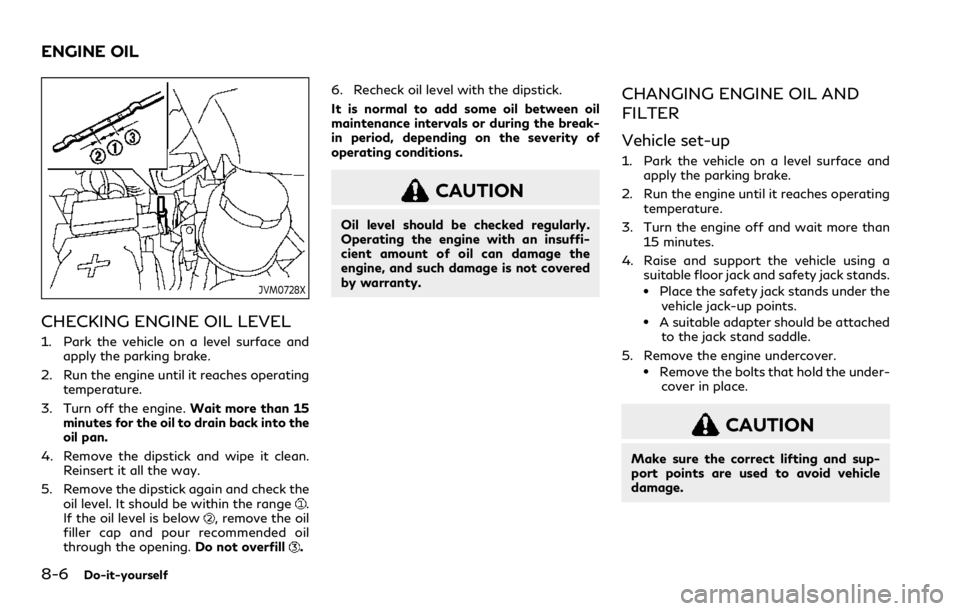
8-6Do-it-yourself
JVM0728X
CHECKING ENGINE OIL LEVEL
1. Park the vehicle on a level surface andapply the parking brake.
2. Run the engine until it reaches operating temperature.
3. Turn off the engine. Wait more than 15
minutes for the oil to drain back into the
oil pan.
4. Remove the dipstick and wipe it clean. Reinsert it all the way.
5. Remove the dipstick again and check the oil level. It should be within the range
.
If the oil level is below, remove the oil
filler cap and pour recommended oil
through the opening. Do not overfill
.6. Recheck oil level with the dipstick.
It is normal to add some oil between oil
maintenance intervals or during the break-
in period, depending on the severity of
operating conditions.
CAUTION
Oil level should be checked regularly.
Operating the engine with an insuffi-
cient amount of oil can damage the
engine, and such damage is not covered
by warranty.
CHANGING ENGINE OIL AND
FILTER
Vehicle set-up
1. Park the vehicle on a level surface and
apply the parking brake.
2. Run the engine until it reaches operating temperature.
3. Turn the engine off and wait more than 15 minutes.
4. Raise and support the vehicle using a suitable floor jack and safety jack stands.
.Place the safety jack stands under thevehicle jack-up points.
.A suitable adapter should be attachedto the jack stand saddle.
5. Remove the engine undercover.
.Remove the bolts that hold the under- cover in place.
CAUTION
Make sure the correct lifting and sup-
port points are used to avoid vehicle
damage.
ENGINE OIL
Page 430 of 529
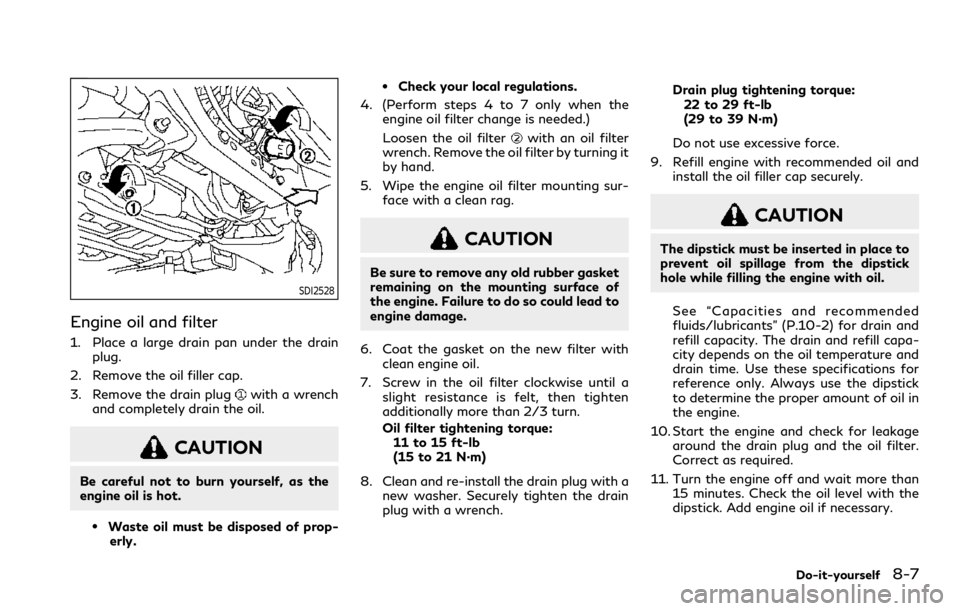
SDI2528
Engine oil and filter
1. Place a large drain pan under the drainplug.
2. Remove the oil filler cap.
3. Remove the drain plug
with a wrench
and completely drain the oil.
CAUTION
Be careful not to burn yourself, as the
engine oil is hot.
.Waste oil must be disposed of prop- erly.
.Check your local regulations.
4. (Perform steps 4 to 7 only when the engine oil filter change is needed.)
Loosen the oil filter
with an oil filter
wrench. Remove the oil filter by turning it
by hand.
5. Wipe the engine oil filter mounting sur- face with a clean rag.
CAUTION
Be sure to remove any old rubber gasket
remaining on the mounting surface of
the engine. Failure to do so could lead to
engine damage.
6. Coat the gasket on the new filter with clean engine oil.
7. Screw in the oil filter clockwise until a slight resistance is felt, then tighten
additionally more than 2/3 turn.
Oil filter tightening torque:11 to 15 ft-lb
(15 to 21 N·m)
8. Clean and re-install the drain plug with a new washer. Securely tighten the drain
plug with a wrench. Drain plug tightening torque:
22 to 29 ft-lb
(29 to 39 N·m)
Do not use excessive force.
9. Refill engine with recommended oil and install the oil filler cap securely.
CAUTION
The dipstick must be inserted in place to
prevent oil spillage from the dipstick
hole while filling the engine with oil.
See “Capacities and recommended
fluids/lubricants” (P.10-2) for drain and
refill capacity. The drain and refill capa-
city depends on the oil temperature and
drain time. Use these specifications for
reference only. Always use the dipstick
to determine the proper amount of oil in
the engine.
10. Start the engine and check for leakage around the drain plug and the oil filter.
Correct as required.
11. Turn the engine off and wait more than 15 minutes. Check the oil level with the
dipstick. Add engine oil if necessary.
Do-it-yourself8-7
Page 431 of 529
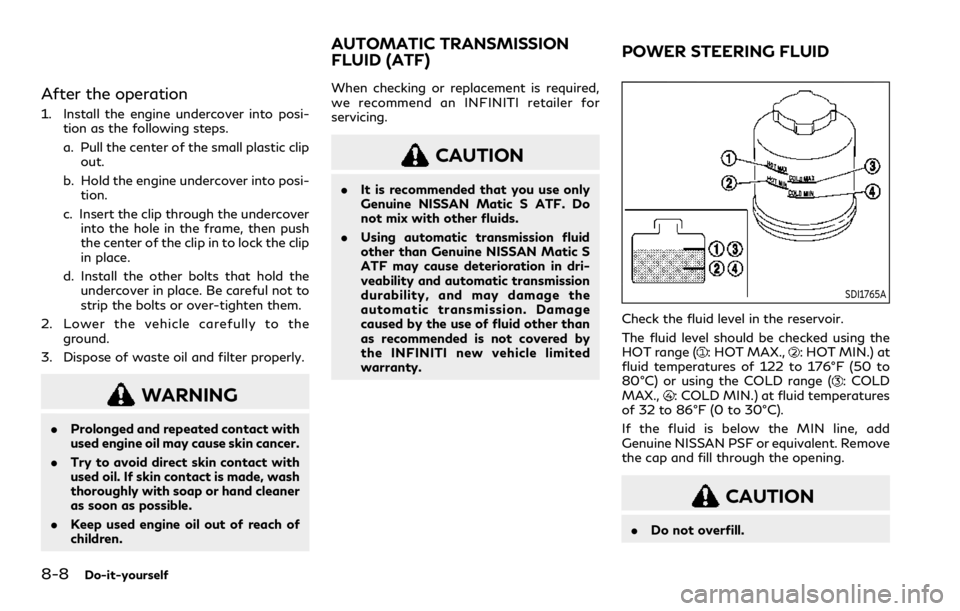
8-8Do-it-yourself
After the operation
1. Install the engine undercover into posi-tion as the following steps.
a. Pull the center of the small plastic clip
out.
b. Hold the engine undercover into posi- tion.
c. Insert the clip through the undercover into the hole in the frame, then push
the center of the clip in to lock the clip
in place.
d. Install the other bolts that hold the undercover in place. Be careful not to
strip the bolts or over-tighten them.
2. Lower the vehicle carefully to the ground.
3. Dispose of waste oil and filter properly.
WARNING
. Prolonged and repeated contact with
used engine oil may cause skin cancer.
. Try to avoid direct skin contact with
used oil. If skin contact is made, wash
thoroughly with soap or hand cleaner
as soon as possible.
. Keep used engine oil out of reach of
children. When checking or replacement is required,
we recommend an INFINITI retailer for
servicing.
CAUTION
.
It is recommended that you use only
Genuine NISSAN Matic S ATF. Do
not mix with other fluids.
. Using automatic transmission fluid
other than Genuine NISSAN Matic S
ATF may cause deterioration in dri-
veability and automatic transmission
durability, and may damage the
automatic transmission. Damage
caused by the use of fluid other than
as recommended is not covered by
the INFINITI new vehicle limited
warranty.
SDI1765A
Check the fluid level in the reservoir.
The fluid level should be checked using the
HOT range (
: HOT MAX.,: HOT MIN.) at
fluid temperatures of 122 to 176°F (50 to
80°C) or using the COLD range (
: COLD
MAX.,: COLD MIN.) at fluid temperatures
of 32 to 86°F (0 to 30°C).
If the fluid is below the MIN line, add
Genuine NISSAN PSF or equivalent. Remove
the cap and fill through the opening.
CAUTION
. Do not overfill.
AUTOMATIC TRANSMISSION
FLUID (ATF) POWER STEERING FLUID
Page 465 of 529

9-4Maintenance and schedules
equipped) hold securely in all latched posi-
tions.
Steering wheel:Check for changes in the
steering conditions, such as excessive free
play, hard steering or strange noises.
Warning lights and chimes: Make sure that
all warning lights and chimes are operating
properly.
Windshield defroster: Check that the air
comes out of the defroster outlets properly
and in sufficient quantity when operating
the heater or air conditioner.
Windshield wiper and washer*: Check that
the wipers and washer operate properly and
that the wipers do not streak.
Under the hood and vehicle
The maintenance items listed here should be
checked periodically (for example, each time
you check the engine oil or refuel).
Battery*: Check the fluid level in each cell. It
should be between the MAX and MIN lines.
Vehicles operated in high temperatures or
under severe condition require frequent
checks of the battery fluid level.
NOTE:
Care should be taken to avoid situations
that can lead to potential battery discharge
and potential no-start conditions such as: 1.
Installation or extended use of electro-
nic accessories that consume battery
power when the engine is not running
(Phone chargers, GPS, DVD players,
etc.)
2. Vehicle is not driven regularly and/or
only driven short distances.
In these cases, the battery may need to be
charged to maintain battery health.
Brake fluid level*: Make sure that the brake
fluid level is between the MAX and MIN lines
on the reservoir.
Engine coolant level*: Check the coolant
level when the engine is cold.
Engine drive belt*: Make sure that no belt is
frayed, worn, cracked or oily.
Engine oil level*: Check the level after
parking the vehicle on a level spot and
turning off the engine. Wait more than 15
minutes for the oil to drain back into the oil
pan.
Exhaust system: Make sure there are no
loose supports, cracks or holes. If the sound
of the exhaust seems unusual or there is a
smell of exhaust fumes, immediately have
the exhaust system inspected. It is recom-
mended you visit an INFINITI retailer for this
service. (See “Precautions when starting and
driving” (P.5-4) for exhaust gas (carbon
monoxide).) Fluid leaks:
Check under the vehicle for fuel,
oil, water or other fluid leaks after the
vehicle has been parked for a while. Water
dripping from the air conditioner after use is
normal. If you should notice any leaks or if
gasoline fumes are evident, check for the
cause and have it corrected immediately.
Power steering fluid level* and lines: Check
the level when the fluid is cold, with the
engine off. Check the lines for proper
attachment, leaks, cracks, etc.
Radiator and hoses: Check the front of the
radiator and clean off any dirt, insects,
leaves, etc., that may have accumulated.
Make sure the hoses have no cracks, defor-
mation, rot or loose connections.
Underbody: The underbody is frequently
exposed to corrosive substances such as
those used on icy roads or to control dust. It
is very important to remove these sub-
stances, otherwise rust will form on the
floor pan, frame, fuel lines and around the
exhaust system. At the end of winter, the
underbody should be thoroughly flushed
with plain water, being careful to clean
those areas where mud and dirt may accu-
mulate. For additional information, see
“Cleaning exterior” (P.7-2).
Windshield washer fluid*: Check that there
is adequate fluid in the reservoir.
Page 467 of 529

9-6Maintenance and schedules
Brake pads and rotors:
Check for wear, deterioration and fluid
leaks. Replace any deteriorated or damaged
parts immediately.
Exhaust system:
Visually inspect the exhaust pipes, muffler
and hangers for leaks, cracks, deterioration,
and damage. Tighten connections or replace
parts as necessary.
In-cabin microfilter:
Replace at specified intervals. When driving
for prolonged periods in dusty conditions,
replace the filter more frequently.
Propeller shaft(s):
Check for damage, looseness, and grease
leakage. (4WD/RWD)
Steering gear and linkage, axle and suspen-
sion parts, drive shaft boots:
Check for damage, looseness, and leakage
of oil or grease. Under severe driving condi-
tions, inspect more frequently.
Tire rotation:
Rotate tires at the specified interval. When
rotating tires, check for damage and uneven
wear. Replace if necessary.
Transmission fluid/oil, differential oil and
transfer case oil:
Visually inspect for signs of leakage at
specified intervals.To help ensure smooth, safe and economical
driving, INFINITI provides two maintenance
schedules that may be used, depending upon
the conditions in which you usually drive.
These schedules contain both distance and
time intervals, up to 120,000 miles
(192,000 km)/96 months. For most people,
the odometer reading will indicate when
service is needed. However, if you drive very
little, your vehicle should be serviced at the
regular time intervals shown in the schedule.
After 120,000 miles (192,000 km)/96
months, continue maintenance at the same
mileage/time intervals.
ADDITIONAL MAINTENANCE
ITEMS FOR SEVERE OPERATING
CONDITIONS
Additional maintenance items for severe
operating conditions;
should be performed
on vehicles that are driven under especially
demanding conditions. Additional mainte-
nance items should be performed if you
primarily operate your vehicle under the
following conditions:
. Repeated short trips of less than 5 miles
(8 km).
. Repeated short trips of less than 10 miles
(16 km) with outside temperatures re-
maining below freezing. .
Operating in hot weather in stop-and-go
“rush hour” traffic.
. Extensive idling and/or low speed driving
for long distances, such as police, taxi or
door-to-door delivery use.
. Driving in dusty conditions.
. Driving on rough, muddy or salt spread
roads.
. Towing a trailer, using a camper or car-
top carrier.
If your vehicle is mainly operated under the
severe conditions, follow the severe main-
tenance intervals shown in the maintenance
schedule.
MAINTENANCE SCHEDULES
Page 482 of 529

10 Technical and consumer information
Capacities and recommended fluids/lubricants ..... 10-2Fuel information ....................................................... 10-4
Engine oil and oil filter recommendation ........... 10-6
Air conditioning system refrigerant and
oil recommendations ................................................ 10-7
Specifications .................................................................. 10-8
Engine ........................................................................\
.. 10-8
Wheels and tires ........................................................ 10-9
Dimensions ............................................................... 10-10
When traveling or registering in
another country ............................................................. 10-11
Vehicle identification ................................................... 10-11 Vehicle Identification Number (VIN) plate ....... 10-11
Vehicle identification number
(chassis number) ...................................................... 10-11
Engine serial number ............................................. 10-12
F.M.V.S.S./C.M.V.S.S. certification label ........ 10-12
Emission control information label ................... 10-12
Tire and loading information label .................... 10-13
Air conditioner specification label ..................... 10-13
Installing front license plate ..................................... 10-15
Vehicle loading information ...................................... 10-15 Terms ........................................................................\
. 10-15 Vehicle load capacity ........................................... 10-17
Securing the load ................................................. 10-18
Loading tips ........................................................... 10-18
Measurement of weights ................................... 10-19
Towing a trailer ........................................................... 10-19 Maximum load limits ........................................... 10-19
Maximum Gross Vehicle Weight (GVW)/
maximum Gross Axle Weight (GAW) ............. 10-21
Towing load/specification ................................. 10-22
Towing safety ....................................................... 10-23
Flat towing ............................................................. 10-31
Uniform tire quality grading .................................... 10-31 Treadwear .............................................................. 10-31
Traction AA, A, B and C ..................................... 10-32
Temperature A, B and C .................................... 10-32
Emission control system warranty ......................... 10-32
Reporting safety defects .......................................... 10-33
Readiness for Inspection/Maintenance
(I/M) test ....................................................................... 10-34
Event Data Recorders (EDR) ................................... 10-35
Owner’s Manual/Service Manual
order information ........................................................ 10-35
Page 488 of 529
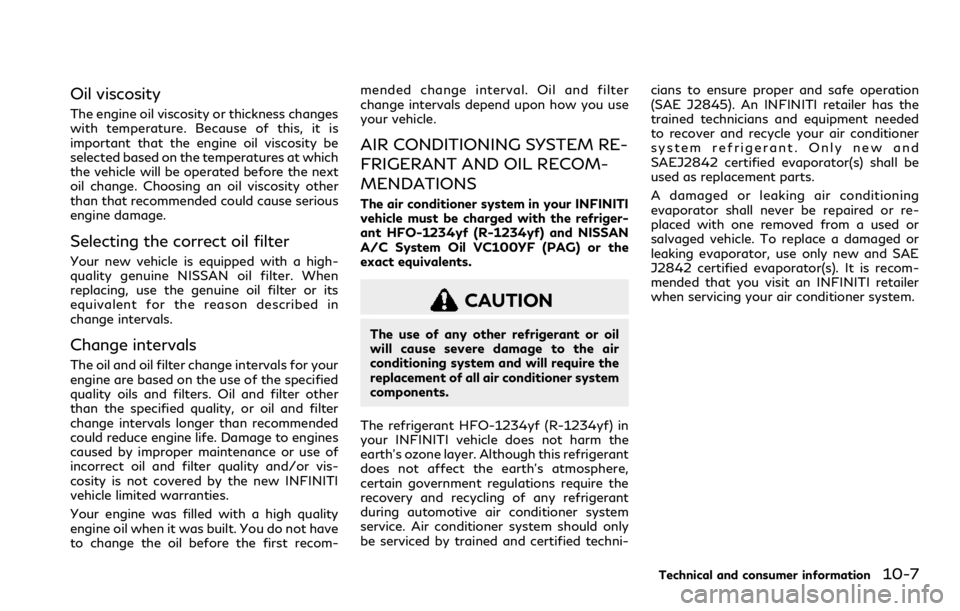
Oil viscosity
The engine oil viscosity or thickness changes
with temperature. Because of this, it is
important that the engine oil viscosity be
selected based on the temperatures at which
the vehicle will be operated before the next
oil change. Choosing an oil viscosity other
than that recommended could cause serious
engine damage.
Selecting the correct oil filter
Your new vehicle is equipped with a high-
quality genuine NISSAN oil filter. When
replacing, use the genuine oil filter or its
equivalent for the reason described in
change intervals.
Change intervals
The oil and oil filter change intervals for your
engine are based on the use of the specified
quality oils and filters. Oil and filter other
than the specified quality, or oil and filter
change intervals longer than recommended
could reduce engine life. Damage to engines
caused by improper maintenance or use of
incorrect oil and filter quality and/or vis-
cosity is not covered by the new INFINITI
vehicle limited warranties.
Your engine was filled with a high quality
engine oil when it was built. You do not have
to change the oil before the first recom-mended change interval. Oil and filter
change intervals depend upon how you use
your vehicle.
AIR CONDITIONING SYSTEM RE-
FRIGERANT AND OIL RECOM-
MENDATIONS
The air conditioner system in your INFINITI
vehicle must be charged with the refriger-
ant HFO-1234yf (R-1234yf) and NISSAN
A/C System Oil VC100YF (PAG) or the
exact equivalents.
CAUTION
The use of any other refrigerant or oil
will cause severe damage to the air
conditioning system and will require the
replacement of all air conditioner system
components.
The refrigerant HFO-1234yf (R-1234yf) in
your INFINITI vehicle does not harm the
earth’s ozone layer. Although this refrigerant
does not affect the earth’s atmosphere,
certain government regulations require the
recovery and recycling of any refrigerant
during automotive air conditioner system
service. Air conditioner system should only
be serviced by trained and certified techni- cians to ensure proper and safe operation
(SAE J2845). An INFINITI retailer has the
trained technicians and equipment needed
to recover and recycle your air conditioner
system refrigerant. Only new and
SAEJ2842 certified evaporator(s) shall be
used as replacement parts.
A damaged or leaking air conditioning
evaporator shall never be repaired or re-
placed with one removed from a used or
salvaged vehicle. To replace a damaged or
leaking evaporator, use only new and SAE
J2842 certified evaporator(s). It is recom-
mended that you visit an INFINITI retailer
when servicing your air conditioner system.
Technical and consumer information10-7
Page 519 of 529
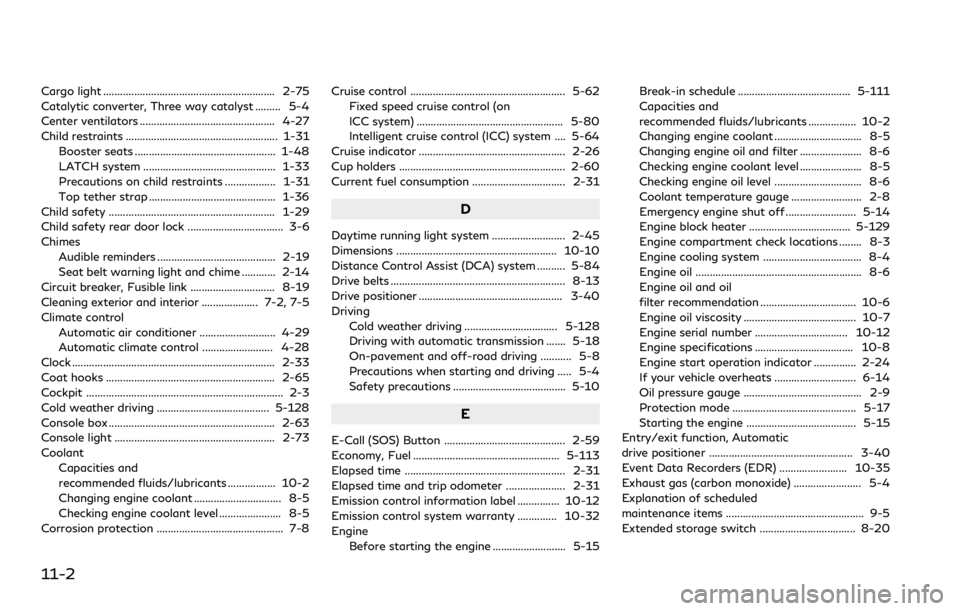
11-2
Cargo light ............................................................. 2-75
Catalytic converter, Three way catalyst ......... 5-4
Center ventilators ................................................ 4-27
Child restraints ...................................................... 1-31Booster seats .................................................. 1-48
LATCH system ............................................... 1-33
Precautions on child restraints .................. 1-31
Top tether strap ............................................. 1-36
Child safety ........................................................... 1-29
Child safety rear door lock .................................. 3-6
Chimes Audible reminders .......................................... 2-19
Seat belt warning light and chime ............ 2-14
Circuit breaker, Fusible link .............................. 8-19
Cleaning exterior and interior .................... 7-2, 7-5
Climate control Automatic air conditioner ........................... 4-29
Automatic climate control ......................... 4-28
Clock ........................................................................\
2-33
Coat hooks ............................................................ 2-65
Cockpit ...................................................................... 2-3
Cold weather driving ........................................ 5-128
Console box ........................................................... 2-63
Console light ......................................................... 2-73
Coolant
Capacities and
recommended fluids/lubricants ................. 10-2
Changing engine coolant ............................... 8-5
Checking engine coolant level ...................... 8-5
Corrosion protection ............................................. 7-8 Cruise control ....................................................... 5-62
Fixed speed cruise control (on
ICC system) .................................................... 5-80
Intelligent cruise control (ICC) system .... 5-64
Cruise indicator .................................................... 2-26
Cup holders ........................................................... 2-60
Current fuel consumption ................................. 2-31
D
Daytime running light system .......................... 2-45
Dimensions ......................................................... 10-10
Distance Control Assist (DCA) system .......... 5-84
Drive belts .............................................................. 8-13
Drive positioner ................................................... 3-40
Driving Cold weather driving ................................. 5-128
Driving with automatic transmission ....... 5-18
On-pavement and off-road driving ........... 5-8
Precautions when starting and driving ..... 5-4
Safety precautions ........................................ 5-10
E
E-Call (SOS) Button ........................................... 2-59
Economy, Fuel .................................................... 5-113
Elapsed time ......................................................... 2-31
Elapsed time and trip odometer ..................... 2-31
Emission control information label ............... 10-12
Emission control system warranty .............. 10-32
EngineBefore starting the engine .......................... 5-15 Break-in schedule ........................................ 5-111
Capacities and
recommended fluids/lubricants ................. 10-2
Changing engine coolant ............................... 8-5
Changing engine oil and filter ...................... 8-6
Checking engine coolant level ...................... 8-5
Checking engine oil level ............................... 8-6
Coolant temperature gauge ......................... 2-8
Emergency engine shut off ......................... 5-14
Engine block heater .................................... 5-129
Engine compartment check locations ........ 8-3
Engine cooling system ................................... 8-4
Engine oil ........................................................... 8-6
Engine oil and oil
filter recommendation .................................. 10-6
Engine oil viscosity ........................................ 10-7
Engine serial number ................................. 10-12
Engine specifications ................................... 10-8
Engine start operation indicator ............... 2-24
If your vehicle overheats ............................. 6-14
Oil pressure gauge .......................................... 2-9
Protection mode ............................................ 5-17
Starting the engine ....................................... 5-15
Entry/exit function, Automatic
drive positioner ................................................... 3-40
Event Data Recorders (EDR) ........................ 10-35
Exhaust gas (carbon monoxide) ........................ 5-4
Explanation of scheduled
maintenance items ................................................. 9-5
Extended storage switch .................................. 8-20
Page 520 of 529
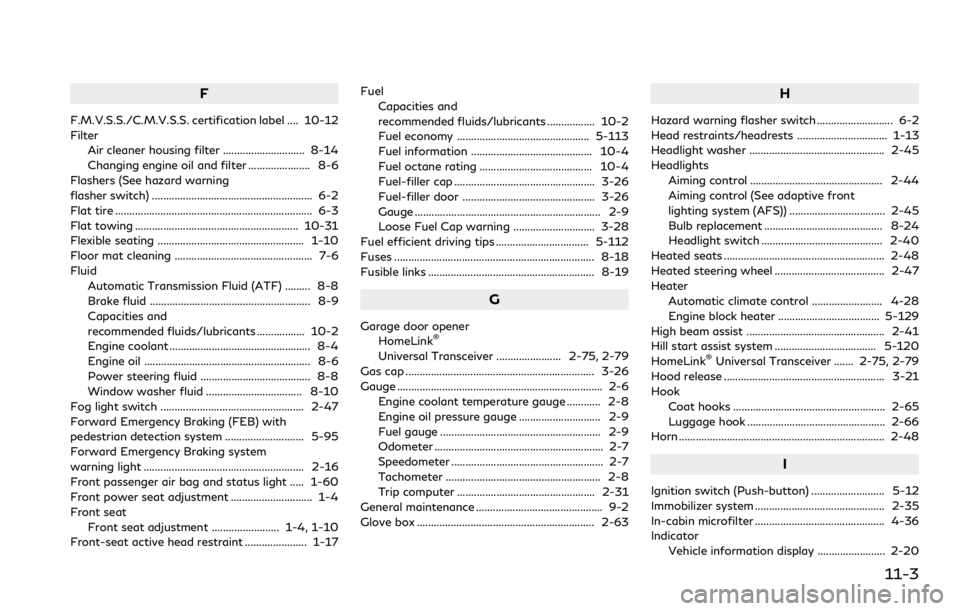
F
F.M.V.S.S./C.M.V.S.S. certification label .... 10-12
FilterAir cleaner housing filter ............................. 8-14
Changing engine oil and filter ...................... 8-6
Flashers (See hazard warning
flasher switch) ......................................................... 6-2
Flat tire ...................................................................... 6-3
Flat towing .......................................................... 10-31
Flexible seating .................................................... 1-10
Floor mat cleaning ................................................. 7-6
Fluid Automatic Transmission Fluid (ATF) ......... 8-8
Brake fluid ......................................................... 8-9
Capacities and
recommended fluids/lubricants ................. 10-2
Engine coolant .................................................. 8-4
Engine oil ........................................................... 8-6
Power steering fluid ....................................... 8-8
Window washer fluid .................................. 8-10
Fog light switch ................................................... 2-47
Forward Emergency Braking (FEB) with
pedestrian detection system ............................ 5-95
Forward Emergency Braking system
warning light ......................................................... 2-16
Front passenger air bag and status light ..... 1-60
Front power seat adjustment ............................. 1-4
Front seat Front seat adjustment ........................ 1-4, 1-10
Front-seat active head restraint ...................... 1-17 Fuel
Capacities and
recommended fluids/lubricants ................. 10-2
Fuel economy ............................................... 5-113
Fuel information ........................................... 10-4
Fuel octane rating ........................................ 10-4
Fuel-filler cap .................................................. 3-26
Fuel-filler door ............................................... 3-26
Gauge .................................................................. 2-9
Loose Fuel Cap warning ............................. 3-28
Fuel efficient driving tips ................................. 5-112
Fuses ....................................................................... 8-18
Fusible links ........................................................... 8-19
G
Garage door opener HomeLink®
Universal Transceiver ....................... 2-75, 2-79
Gas cap ................................................................... 3-26
Gauge ........................................................................\
. 2-6 Engine coolant temperature gauge ............ 2-8
Engine oil pressure gauge ............................. 2-9
Fuel gauge ......................................................... 2-9
Odometer ............................................................ 2-7
Speedometer ...................................................... 2-7
Tachometer ....................................................... 2-8
Trip computer ................................................. 2-31
General maintenance ............................................. 9-2
Glove box ............................................................... 2-63
H
Hazard warning flasher switch ........................... 6-2
Head restraints/headrests ................................ 1-13
Headlight washer ................................................ 2-45
Headlights Aiming control ............................................... 2-44
Aiming control (See adaptive front
lighting system (AFS)) .................................. 2-45
Bulb replacement .......................................... 8-24
Headlight switch ........................................... 2-40
Heated seats ......................................................... 2-48
Heated steering wheel ....................................... 2-47
Heater Automatic climate control ......................... 4-28
Engine block heater .................................... 5-129
High beam assist ................................................. 2-41
Hill start assist system .................................... 5-120
HomeLink
®Universal Transceiver ....... 2-75, 2-79
Hood release ......................................................... 3-21
Hook Coat hooks ...................................................... 2-65
Luggage hook ................................................. 2-66
Horn ........................................................................\
. 2-48
I
Ignition switch (Push-button) .......................... 5-12
Immobilizer system .............................................. 2-35
In-cabin microfilter .............................................. 4-36
Indicator
Vehicle information display ........................ 2-20
11-3
Page 522 of 529
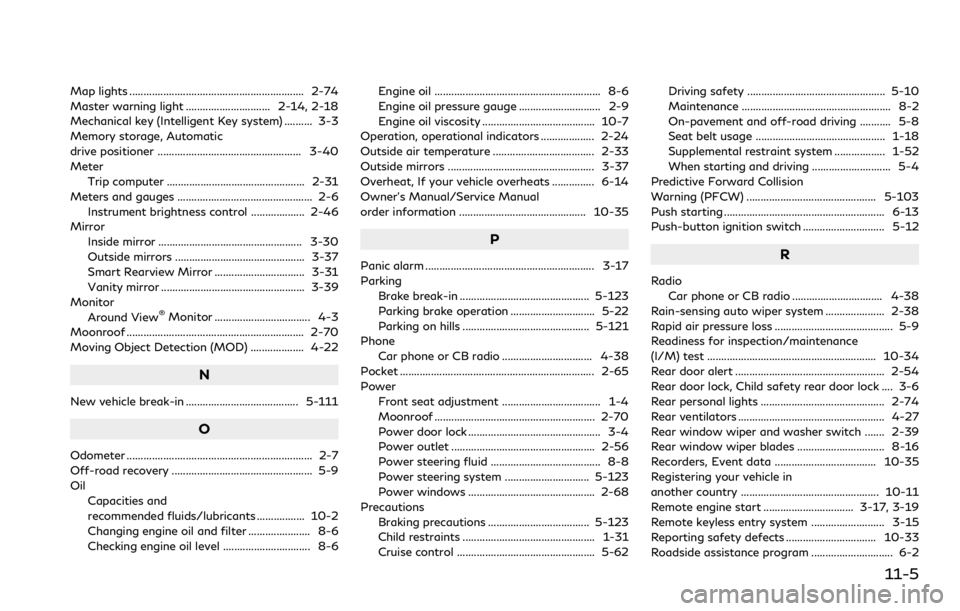
Map lights .............................................................. 2-74
Master warning light .............................. 2-14, 2-18
Mechanical key (Intelligent Key system) .......... 3-3
Memory storage, Automatic
drive positioner ................................................... 3-40
MeterTrip computer ................................................. 2-31
Meters and gauges ................................................ 2-6 Instrument brightness control ................... 2-46
Mirror
Inside mirror ................................................... 3-30
Outside mirrors .............................................. 3-37
Smart Rearview Mirror ................................ 3-31
Vanity mirror ................................................... 3-39
Monitor
Around View
®Monitor .................................. 4-3
Moonroof ............................................................... 2-70
Moving Object Detection (MOD) ................... 4-22
N
New vehicle break-in ........................................ 5-111
O
Odometer .................................................................. 2-7
Off-road recovery .................................................. 5-9
Oil Capacities and
recommended fluids/lubricants ................. 10-2
Changing engine oil and filter ...................... 8-6
Checking engine oil level ............................... 8-6 Engine oil ........................................................... 8-6
Engine oil pressure gauge ............................. 2-9
Engine oil viscosity ........................................ 10-7
Operation, operational indicators ................... 2-24
Outside air temperature .................................... 2-33
Outside mirrors .................................................... 3-37
Overheat, If your vehicle overheats ............... 6-14
Owner’s Manual/Service Manual
order information ............................................. 10-35
P
Panic alarm ............................................................ 3-17
Parking Brake break-in .............................................. 5-123
Parking brake operation .............................. 5-22
Parking on hills ............................................. 5-121
Phone
Car phone or CB radio ................................ 4-38
Pocket ..................................................................... 2-65
Power Front seat adjustment ................................... 1-4
Moonroof ......................................................... 2-70
Power door lock ............................................... 3-4
Power outlet ................................................... 2-56
Power steering fluid ....................................... 8-8
Power steering system .............................. 5-123
Power windows ............................................. 2-68
Precautions Braking precautions .................................... 5-123
Child restraints ............................................... 1-31
Cruise control ................................................. 5-62 Driving safety ................................................. 5-10
Maintenance ..................................................... 8-2
On-pavement and off-road driving ........... 5-8
Seat belt usage .............................................. 1-18
Supplemental restraint system .................. 1-52
When starting and driving ............................ 5-4
Predictive Forward Collision
Warning (PFCW) .............................................. 5-103
Push starting ......................................................... 6-13
Push-button ignition switch ............................. 5-12R
Radio Car phone or CB radio ................................ 4-38
Rain-sensing auto wiper system ..................... 2-38
Rapid air pressure loss .......................................... 5-9
Readiness for inspection/maintenance
(I/M) test ............................................................ 10-34
Rear door alert ..................................................... 2-54
Rear door lock, Child safety rear door lock .... 3-6
Rear personal lights ............................................ 2-74
Rear ventilators .................................................... 4-27
Rear window wiper and washer switch ....... 2-39
Rear window wiper blades ............................... 8-16
Recorders, Event data .................................... 10-35
Registering your vehicle in
another country ................................................. 10-11
Remote engine start ................................ 3-17, 3-19
Remote keyless entry system .......................... 3-15
Reporting safety defects ................................ 10-33
Roadside assistance program ............................. 6-2
11-5